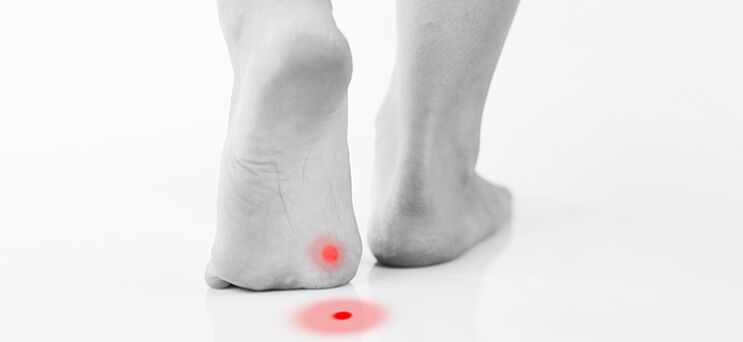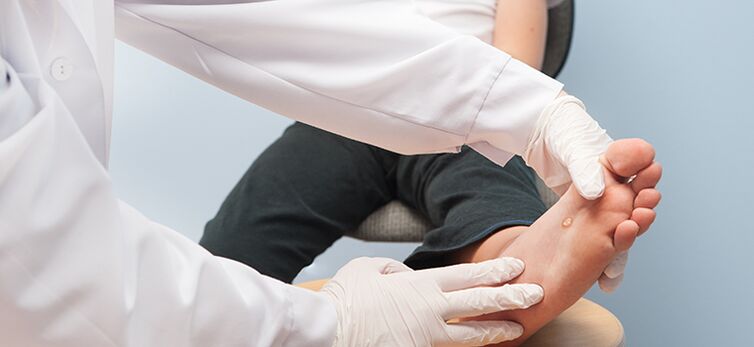plantar warts, or spikes, which look like hard-to-touch, flat structures on the skin of the feet, just above skin level. This type of wart refers to an epithelial tumor, is benign in nature, and diagnosis usually does not pose difficulties - the main method is dermoscopy. Doctors use a special device to visually determine the nature of the new formation. Warts can occur anywhere on the foot, but usually form on the toes, the ball of the heel, where the pressure is greatest. This photo clearly shows what a plantar wart looks like, and its appearance is very specific and usually doesn't raise doubts about the diagnosis. The formation has a dirty brown or unpleasant yellow color, with characteristic coarse papules visible, disrupting the papillary pattern.

Since the formation is on the foot, this can cause pain and injury to the wart itself. For these reasons, the spines need to be treated, although it is very unlikely that plantar warts will go away on their own without serious treatment.
Unfortunately, getting rid of warts is still not easy, so consultation with a dermatologist is recommended to reduce the risk of infecting others, as well as reduce the time to treat the disease. It is not advisable to use only folk remedies and independent attempts to get rid of the tumor. Plantar warts have deep roots and are nearly impossible to remove on their own, so they recur. Folk remedies often severely damage surrounding tissue, which can lead to increased damage and unpleasant consequences in the form of burns and scars.
symptom
If you suspect a tumor, you should not only know what the plantar wart looks like in the photo, but also remember that the disease has characteristic symptoms:
- Significant itching at the site of formation;
- Warts vary in size from a few millimeters to 2 centimeters;
- Unlike corns, warts can be painful;
- bleeding when injured;
- Pain when walking.
If you experience similar symptoms, contact your doctor immediately. It is easier to prevent disease than to deal with the consequences.
Causes of Plantar Warts
Plantar warts are caused by human papillomavirus (HPV) infection of the feet. The main route of transmission is contact, and infection occurs through ordinary objects or direct human-to-human transmission. A good environment is warm and humid, so it's important to take precautions when visiting tubs, swimming pools, saunas, and gyms.
It can also happen because of a weakened immune system, because under normal conditions, HPV does not give an obvious manifestation.
This type of wart can also occur with microtrauma to the epidermis, dry skin, uncomfortable tight shoes, and hyperhidrosis. In addition, leg warts can be caused by diseases that lead to deformities of the feet - arthritis of the joints, osteoarthritis, flat feet, and diseases that lead to impaired skin integrity of the feet: diabetes, varicose veins. It must be remembered that frequent stress can indirectly influence the occurrence of this disease.
HPV can be acquired accidentally during normal barefoot walking on an infected surface, and the virus can survive for months without an immediate carrier. After entering the body, it may not appear for days or even weeks, which is why it is not always possible to know exactly when the infection occurred.
diagnosis
To determine how to treat plantar warts, dermatologists conducted a series of studies:
- ordinary inspection;
- dermoscopy;
- PCR diagnosis;
- Histological examination.
How to Treat Plantar Warts

When plantar warts appear, the question arises how to cure the tumor. When a growth causes excessive discomfort and spreads rapidly, the best solution is to contact a dermatologist as soon as possible, who will choose the most appropriate treatment option. There are several ways to solve this problem.
The most radical of these is surgical: surgical removal of the wart and its roots. This method is not the most effective because the root of the tumor is deep in the skin. In some cases, it is not possible to remove them completely.
Warts can be removed using laser and electrocoagulation, as well as cryotherapy.
In addition to being removed in a medical facility, plantar warts can be removed with less aggressive methods such as ointments, solutions, special patches, and folk remedies. These methods of removing plantar warts have many advantages and disadvantages, mainly the long treatment time.
remove plantar warts
One of the most common ways to remove plantar warts is to have them removed in a professional medical facility. The dermatologist at the appointment will give you detailed instructions on how to remove the plantar wart and choose the most appropriate method based on the results of the test. Although thorns are difficult to cure, there is no specific, specific way to remove them; all methods associated with treating other types of warts can be used. Plantar wart removal can be done on an outpatient basis, but your doctor may prescribe remedies to help you remove the growths at home.
surgical removal of warts
Along with other treatments, surgical intervention is used to remove warts. The wart is scraped out with a special scalpel under local anesthesia. Following this procedure, if the size of the plantar wart is fairly large, sutures are placed under the skin and removed within one to two weeks. Treat the wound site with an antiseptic solution and use a sterile bandage. There is usually a small scar at the removal site.
The difficulty with this method is that the doctor must remove the entire root during the operation, otherwise the plantar wart will reappear. Therefore, this method is only used today when all other treatments have failed.
Remove with liquid nitrogen
Removal with liquid nitrogen involves exposing the tumor to extremely low temperatures, which is the most common and fastest modern method of treating plantar warts.
The method is based on freezing the formation tissue itself. In fact, inside the wart cells, under the influence of extremely low temperatures of -196 degrees Celsius, rupture occurs, causing the wart to die.
Cryodestruction is done manually or by hardware. Local anesthesia is necessary if the wart is large or if surgery is performed on a child.
Direct exposure to liquid nitrogen for up to 30 seconds. After the first cautery, the physician should pause to assess the effectiveness of the effect and the need for another cautery.
After freezing, air bubbles with colorless or reddish fluid form at the wart site, which indicates the beginning of an inflammatory process. This is a normal reaction to the cautery process.
Cryosurgery is considered to be painless, but when treating plantar warts, it must be repeated multiple times to achieve the final result. After the wart falls off, no scar is left.
The advantages of liquid nitrogen removal are:
- Freezing eliminates further spread of disease to the nearest skin;
- lack of special training;
- Short operation time;
- There is little risk of scarring or scarring.
The disadvantages of cryo-destruction of plantar warts are:
- Requires a second course of treatment for extensive damage or due to the size of the wart;
- Human Factor - The professionalism of the doctor performing this procedure is a guarantee of success. Doctors must properly assess the timing and extent of tissue exposure to nitrogen, otherwise burns may occur;
- Discomfort from a swollen bladder and the need to deal with it are also considered disadvantages of this method.
In general, feedback for cauterizing plantar warts with liquid nitrogen has been positive, as it is the easiest, most effective, and affordable method.
laser removal
Laser removal is considered one of the most effective and safest methods. After laser treatment, warts are no longer contagious. The procedure itself is painless, and a special nozzle built into the laser cools the impacted site. Additionally, one or more injections of anesthesia will be given before the surgery. Patients usually experience a slight tingling sensation during the procedure. After the tumor is removed, no traces are left, as the laser directly burns away the diseased tissue. The laser method allows maximum control over the exposure depth, which is individual in each case. Therefore, even with deep tissue lesions, the roots can be completely removed, which means that warts are prevented from growing again.
The operation is performed under sterile conditions, with no direct contact with the skin or wart, and the operation time is only a few minutes. The positive results of removing plantar warts with lasers also make this method the most attractive.
The main disadvantage of laser plantar wart removal is the high cost, which usually involves a doctor's consultation, anesthesia, and the surgery itself. In addition, the wound after removal takes a long time to heal and requires compliance with hygiene rules.
Plantar Wart Treatment
Before treating plantar warts, you need to make sure the diagnosis is accurate and then go straight to surgery. In addition to surgery, your doctor may prescribe immunotherapy and topical medications.
Often, the need for immunotherapy is justified because the disease is caused by a virus that actively develops in a debilitated state. Topical immunotherapy directly affects the virus in two ways. In the first case, the drug stimulates the immune system, and in the second case, injecting the wart with an antigen can also activate the immune system and make the wart disappear faster.
The treatment of plantar warts can take quite a while and it is important not to forget to boost the immune system and maintain hygiene. Without removal and treatment, warts can fall off on their own for more than a year, and the person is a source of infection for everyone around. You should think carefully about this unpleasant disease and be sure to contact a dermatologist who will surely tell you how and how to treat plantar warts.
The treatment of plantar warts directly depends on the observance of all hygiene standards and the doctor's prescription; daily treatment of plantar warts is the guarantee of a successful recovery.
treatment at home
Any new formation on the skin should not go unnoticed, as cancer pressures are growing all over the world. Don't overlook an appointment with a specialist who can treat plantar warts at home. In such cases, special solutions, ointments, and wart patches are usually prescribed.
Ointments are one of the mildest treatments, and they act on the wart itself, so it gradually dies and disappears. The following types of ointments are used in the treatment:
- antiviral ointment;
- acid ointment;
- Various ointments based on herbs.
Apply any type of ointment to the wart point by point several times a day, according to the instructions. When treating plantar warts, it must be steamed with warm water before medication. It is recommended to apply any ointment at night so you don't have to step on the formation and wash off the ointment.
To get rid of plantar warts at home, you can use special patches based on salicylic acid. The tool is low cost and proven effective. Sold in pharmacies without a prescription, the patch is simple to use—a patch seals the wart, and a common medical patch is attached to it. You need to replace patches regularly. It can take about two weeks to remove a small wart, and you shouldn't leave a wart without a patch for long periods of time. As the treatment progressed, the area of the wart decreased, and after 12 hours it was covered with a scab, which then disappeared. After successful treatment, a small pink spot will remain on the skin, which should disappear completely over time.
Care must be taken when applying the patch - when applying, avoid healthy areas of the skin or severe irritation may occur. There are contraindications to using this method of wart removal, so it should be up to your doctor to prescribe a patch.
Another way to treat plantar warts at home is hyperthermia. Soak the wart-affected foot in as hot water as possible. This procedure is repeated several times. In some cases, hyperthermia has shown positive effects. The mechanism of this procedure is based on the excitation of small blood vessels in the legs and the activation of local immunity.
At home, you can use a low temperature treatment, similar to removing warts with liquid nitrogen. For this, you can use a special pen applicator or spray. As with cryosurgery, multiple applications may be required.
Healing with folk remedies
Although modern medicines are more effective and the process of removing plantar warts with their help is faster, the effectiveness of treatment with folk remedies cannot be denied. Traditional medicine has accumulated a wealth of experience in the prevention and treatment of warts, and some methods are still effective.
- Celandine juice is one of the most popular ways to get rid of thorns. You can use the juice of the fresh plant or buy medicines that contain other herbal extracts in addition to celandine juice at the pharmacy. Apply the juice to the affected area once or twice a day.
- Acetic acid, along with various other products, can also be used to remove warts. In addition to the acid, onions and flour are used. You can drop the acid directly on the affected area, but this method is very dangerous because of the high risk of severe burns.
- Apple Cider Vinegar: Apply a cotton swab soaked in the solution (it's important not to use undiluted vinegar) to the affected area of the skin and give the skin area an initial treatment with an abrasive nail file.
- Garlic is another folk remedy for warts. Raw garlic should be rubbed on the formation until it is completely gone, but this method can be used for no more than three weeks.
- Apply the inside of the banana peel to the affected skin, which is believed to stretch the wart.
To spot the lesion without affecting adjacent tissue, a piece of tape can be used. A hole is made in it according to the size of the tumor, and the adjacent healthy skin remains intact. This avoids burns and other injuries.
Plantar warts in children
As a person ages, a person develops immunity to HPV, so children and young adults are more susceptible to this infection. Mostly, the disease affects children over the age of five. A doctor will help identify plantar warts in children because in some cases it can resemble old corn.
While your child's plantar warts will go away on their own, their treatment shouldn't be ignored, and it's worth keeping in mind the possibility of infecting the entire family and those around you. Plantar warts in children almost always cause severe pain and discomfort when walking and require prompt treatment and a visit to a doctor.
Because children are sensitive to pain, it can be difficult to find a cure. First, it's worth using a variety of ointments—they're affordable, easy to use, and effective. Folk remedies are also widely used, and their safety is beyond doubt.
Effective ways to remove plantar warts in children are liquid nitrogen and laser removal. Using these methods to remove warts is one of the most aggressive. Use them in cases where solutions and ointments do not have the desired effect.
After treatment, it is important not to forget to prevent plantar warts in children. It's about strengthening the immune system, paying attention to hygiene, and wearing the right comfortable shoes. It should be remembered that the risk of infection is particularly high in public places and from others, so you need to make sure that your child does not wear other people's shoes or walk barefoot. Anything in direct contact with the formation must be thoroughly cleaned at high temperatures. All of these actions will help prevent the virus from developing in the future.
Danger
If the plantar wart removal procedure is not carried out in a timely manner, this can lead to serious consequences, such as:
- warts on other parts of the skin;
- skin cancer.
Doctors strongly advise against self-medicating—cutting, piercing, or burning the wart can make the condition worse and lead to the formation of new warts.
risk group
The risk groups are:
- People with hormonal imbalance in the body;
- infected with HIV.
prevention

To prevent plantar warts, patients are advised to:
- enhance immunity;
- Eat foods rich in vitamins;
- proper care of the skin of the feet;
- Do not wear tight shoes, shoes made of synthetic materials;
- Do not walk barefoot in public places (changing rooms, showers).















